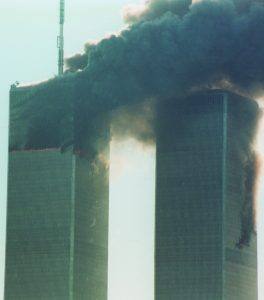 Ten years after the 9/11 events people still ask themselves: how could this happen in a system that was believed to be the most secure in the world? The present paper’s aim is to analyse whether the terrorist attacks that occurred on September, the 11th , 2001 over the U.S. homeland could have been stopped or even prevented by the American intelligence community.
Ten years after the 9/11 events people still ask themselves: how could this happen in a system that was believed to be the most secure in the world? The present paper’s aim is to analyse whether the terrorist attacks that occurred on September, the 11th , 2001 over the U.S. homeland could have been stopped or even prevented by the American intelligence community.
The American Intelligence Agencies (namely CIA and FBI) were known to be some of the most effective services in terms of protecting USA’s national interest, both inside and outside their territory. But the 9/11 events seemed to challenge this hypothesis, if information regarding the available data prior to the attacks are to be taken into consideration (e.g. lack of communication between agencies, break of intelligence cycle, issues regarding human resources). CIA and FBI failed to communicate and to prioritize the coming threats. All these bound the Intelligence Agencies in a chain of mistakes which lead to the most known terrorist attack, which completely changed the perception upon the nature of threats and states’ capabilities to ensure the individual security of its citizens.
The 9/11 attacks were probably the most important events that happened after the collapse of the Cold War system. They changed the entire perception of the international system (states, international institutions\organizations), which used to see threats in a traditional form- as coming from other states, as being symmetrical. Faced with a new kind of threat, the United States had a major problem: they had the capabilities to react, but to react against whom? Terrorist groups do not belong to a single state. Secondly, the most important question is not referring to the reaction, but to the prevention aspect. Additionally, how could this have happened to U.S.A., the guarantee of the present status-quo regarding the balance of power at international level? Moreover these events did not change only the perception regarding the nature of threat (it was seen as a problem coming from outside), but also regarding the intelligence community’s effectives. It was obvious that it had to be reformed given the fact that this major incident revealed major lacks that eventually proved to be crucial in preventing and responding to such events.
The hypothesis that I choose to put under analysis is that the attack was more a tactical surprise than a strategic one (the intelligence services had the information about a possible future attack, but they failed to see that U.S. territory was the terrorists’ target).
The methodological apparatus consists of official documents analysis and experts’ opinions regarding this subject. Through it I try to present an analytical view over the information that was available to the American intelligence agencies prior to the attacks, how much was processed and analyzed and how much was not. I also take into consideration the human aspect as part of the system failure (inappropriate training, lack of communication between agencies). In order to establish a glibly picture of the 9/11 events, I will briefly present a chronological analysis over the events in order to emphasize the causes and the immediate, medium and long term effects.
On September, the 11th, 2001, 19 terrorists belonging to al Qaeda group hijacked 4 commercial planes (one hit a field in Pennsylvania, 2 of them crashed in New York into the World Trade Centre Towers and the last one hit the Pentagon). The impact was huge: 3000 persons were killed. FBI officials insisted that „the notion of flying a plane into a building or using it as a bomb never came up.” After the attack, on February, the 14th, 2002, a joint inquiry was started by the Senate Select Committee on Intelligence and the House of Representatives Permanent Select Committee on Intelligence in order to find answers to questions such as: Did the Intelligence Community know about the possibility of an attack prior to September 11? What did it know regarding the nature and the scope of any possible future terrorist attacks? If they had any, what did they do with the information and „how and to what degree the elements of the Intelligence Community have interacted with each other, as well as with other parts of the federal, state, and local governments, with respect to identifying, tracking, assessing, and coping with international terrorist threats.”
Starting with 1998, the American intelligence community received information about an unidentified group that planned to crash with an explosives-laden airplane into the World Trade Centre building. Since then enormous amounts of information were collected and interpreted.
Two of the most important figures regarding the terrorist attacks were: Nawaf al- Hazmi and Khalid al-Mihdhal, two of the five hijackers of the American Airlines Flight 77 that hit the Pentagon. CIA had them in sight since January 2000, when they met with other al Qaeda followers in Malaysia. The first had a valid U.S. visa and the second had travelled several times to the U.S.A. in 2000. On the time of the investigation FBI authorities said they were not informed about the visa and the travels of the two until August 2001. During the investigation it was discovered that the FBI agents were not aware of CIA procedures, of the ways in which they could access the information or how to obtain additional ones from CIA. This aspect reveals the lack of communication and the failure to share information between the two most important intelligence agencies in America. The information sharing was no better within FBI, because the authorities did not provide guidance to their own federal agents about what information was represented a „threat” and which part of this information was to be disseminated within FBI, and which part to the Intelligence Community.
Given all the afore mentioned, it is understandable and even predictable to see that this lack of information and knowledge jeopardized the intelligence cycle. As presented by Loch K. Johnson, the intelligence cycle stays at the base of the entire range of actions done by an intelligence agency. In order to be organized and effective, an agent must acknowledge all phases: planning and direction, collection, processing, analysis and production, dissemination and new requirement. Within and outside FBI the sharing of intelligence information system was ad hoc rather than systematic. „The FBI’s normal process for disseminating intelligence information was to route it primarily to analysts.” Then, the analysts used their own judgement, expertise and experience in order to decide which was the information that needed to be disseminated and to whom. This had not been a major problem, if the volume of information was not a huge. Given this situation they had little time at disposal so the information that did not represent an immediate threat or did not need immediate attention „was not addressed thoroughly or timely.” Applied to these events, until now, we can at least identify the problem in the dissemination phase. The information was not disseminated properly, fact that damaged the analysis’s quality, because, due to internal problems, it did not reach its target. Within FBI, the information system lacked efficiency, because there were no mechanisms that allowed them to share or capture institutional knowledge. To sum up the problems that appeared between FBI and CIA at institutional level, they included: FBI agents’ lack of understanding of CIA procedures, the counterterrorism investigations were not fore grounded and the impact of the „wall” between intelligence and criminal investigations.
In 2001 the reports intensified. The European allies such as the German intelligence warned CIA agents that terrorists, who were coming from the Middle East, were training for hijackings. Also, the Russian President Vladimir Putin alerted U.S. authorities of suicide pilots training for attacks on U.S. targets. These were perceived as threats to U.S. interest and not to U.S. territory. Even when a Taliban emissary warned them that bin Laden was planning a huge attack on American soil, the intelligences agencies refused to see that they needed to pay more attention to the internal security of America and not to the external one. During the spring of 2001, the intelligence community was already on alert given the large number of reports regarding terrorist threats and possible future attacks. As a reaction to these signs, on April 13 FBI asked all its field officers to use all their resources, human and electronic database, in order to find out anything regarding the „current operational activities relating the Sunni extremism”. In May 2001, Attorney General John Ashcroft reported the fact that the US. embassy received a call from an anonymous source saying that Bin Laden was planning an attack against the Unites States. They were intending to use „high explosive”. The intelligence agents received also information about possible attacks in Israel or Italy. These report were sent to President Bush as morning intelligence briefs, but he discussed about general threats that could rise against America and the American citizen. Regarding the specific threats they were seen more as being overseas15. Also in May, CIA Counter Terrorism Centre (CTC) Chief said that the current level of threat was around 7 (on a scale of 1-10), compared to 8, the level of threat reached during the millennium. During June and July the threat was imminent, but in countries such as: Yemen, Israel, Italy, Saudi Arabia, even during the G8 Summit. Hence, the threat was real and imminent, but it could have been everywhere. During this time, CIA released a report regarding the fact that Khalid Sheikh Mohammed was recruiting people in order to travel to the U.S. „to meet with colleagues already there so that they might conduct terrorist attacks on Bin Laden’s behalf”. That same month, CIA notified all its station chiefs regarding a possible al Qaeda attack. Its reports were presenting the upcoming events as having huge consequences over the perception of the entire world. These attacks could have been multiple, but not necessary simultaneous. They were anticipated to happen in July. In mid-July the reports were saying that al Qaeda plans were delayed, but „will still happen”. Therefore, the Intelligence Community expected the attacks to come, but other details were obscure because despite that huge amount of incoming information, it contained few specific ones regarding the target, the time of the attack, the method that would be used and the place of the attack. But most of these suggested the fact that they were against „U.S. interests” overseas and not against U.S. homeland. This fact is revealed in a statement that was done by the FBI officials in the Summer of 2001: „ the FBI has no information indicating a credible threat of terrorist attack in the United States.”
As fore mentioned, the intelligence cycle represents the base of an intelligence agency work. Within it an important step is the processing level. Here the raw information/ intelligence (pictures, photographs, telephone intercepts) become readable, useful, and meaningful. Without this stage, the information no matter how important it is, it remains information that cannot be used, as it is not read. Therefore, one does not know what it represents, for what it can be used, and it is not known which of the thousands of photographs and telephone intercepts are useful and which are not. A mistake that occurs here can change the result entirely or can avert the analyst from coming to one. On 8/11 the National Security Agency intercepted a telephone message which was coming from an al Qaeda suspected operative. Because of the lack of translators in proficient Arabic, the message was translated on September 12th . It was saying: „Tomorrow is the zero hour”. It was already too late, the attacks occurred on September 11 and they caught everyone off guard. „The foreign intelligence agencies were watching overseas, alert to foreign threats to U.S. interests there. The domestic agencies were waiting for evidence of a domestic threat from sleeper cells within the United States, no one was looking threat to domestic target”.
Regarding the failure that occurred during the processing step mentioned earlier, there is not just the fact that the translation was done too late, the question is why. In this situation, the problem relays in the human aspect. Prior to 9\11, FBI did not complete even an assessment regarding the possible terrorist threat over the United States homeland19. This is a problem of „conceptual failure”, because it failed to look with sufficient weight to: the possible non-traditional target (the U.S. own national territory); to a new, non-traditional threat, as terrorism, which might use non-traditional weapons, such as commercial airplanes.
Another important reason for why the events from 9\11 were not been stopped is the fact that within FBI collection of intelligence, data from human resources was limited. Also in the case of CIA, it was discovered the fact that it lacked HUMINT. One element without which the intelligence services would not exist is still the individual or the HUMINT. Although the level of technology developed over the years, HUMINT in still a necessary tool. For example, in closed groups such as al Qaeda, an intelligence agency would definitely prefer to have an inside agent. The information that this individual could offer may worth more than a dozen satellites. But to be able to infiltrate, an intelligence agent needs to be trained. Even if he is an analyst or a field agent, he needs to know the language, the costumes of the group etc. But many times he (especially when he is an analyst) is put in a situation in which he must learn during „on-the-job training”. Regarding the training of its counterterrorism agents, FBI authorities did not allocate sufficient resources in order to meet the needs for surveillance operations and for translation. The latter is a very important aspect: it did not have enough translators that were proficient in Arabic or other key languages. This aspect proved to be vital if we take into consideration the fact that they could have changed the entire development of events. To sum up the events, we can assume the former CIA Deputy Director, John Gannon’s declaration, who in 1999 was the National Intelligence Council chairman. He simply noted that: „They couldn’t prioritize what was the most significant threat.“
Therefore, the 9/11 attacks were clearly an example of intelligence failure, which had to happen in order for the system to be reformed, as it needs to be able to respond to new kinds of threats. I believe that this entire sequence of events can be seen more as a tactical surprise and not as a strategic one as many tried to argue, mainly because Bin Laden and al Qaeda were known enemies by the American Intelligence Community, hence they should have expected some sort of attack. The surprise came up when they attacked the U.S. homeland, location that was not foreseen because of many intelligence failures (lack of timing, lack of communication, lack of proper training etc), with dreadful consequence that still persist in our minds. Unfortunately, this event had to happen in order for the national states and the international security organizations to realize that the nature of the current threats require new, non-traditional responses. But before being able to identify these new kind of response or the needs of the present security architecture, the intelligence agencies failed to prevent the most known terrorist attack, event that changed completely the states’ perception over their internal security and their ability to ensure it. The adaptation process required a thorough analysis of the lacks, which entailed identifying the internal problems of the American Intelligence Agencies. And, as shown above, in the case of the 9/11 attacks, they were many.









